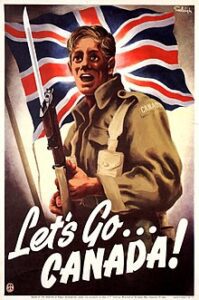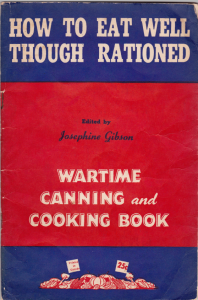Sydney Fuhrman
Watch our Education Coordinator attempt to make this rationing recipe from World War II:

It’s fun to look at Canadian cuisine through the lens of the dishes we all know and love, but sometimes it’s important to see the food that got the country through hardships too. If you’re like me, you’ve probably never heard of the Canada War Cake before reading this. It’s not something we’re known for, it’s not weird or surprising, or covered in maple syrup. In fact it’s a pretty basic raisin loaf. But it tells part of the story of the Canadian homefront during World War II.
Before we dive in, I think it’s important to acknowledge that this story, the story of the War Cake, is only one side of Canada’s World War II history. It’s easy to remember a united front, where people willingly and gladly sacrificed for the common good, and that did happen. But there was also fear, prejudice and even hatred among the Canadian people. So while there are parts of this story that we can feel proud of, it’s important to remember that not every Canadian had the same experiences.
Food is one of the best ways to see how the war impacted Canadians on a day-to-day basis. For one thing, food shortages were constant. It was unavoidable; many farms relied on the labour of young men of fighting age, and when they went overseas the farms were left short handed. Additionally, fighting in the Atlantic made imports harder to access and finally, a lot of essential foodstuffs were sent to frontlines and Britain instead of Canada. In fact in 1941, 77% of the wheat consumed by the British people came from Canadian producers, as well as large percentages of their bacon, eggs, cheese and milk. Our allies were counting on us, but this meant there was less food available for Canadians.
To make matters worse, shortages led to price jumps. Because foods like sugar and butter were hard to come by, but still staples for households, stores were able to charge a lot of money for them. This made it harder for lower income families to make do. As a result the government stepped in with price caps and rationing. Price caps set a maximum price that a given product could be sold for making it so that even when there were shortages everyone could continue to afford the necessities. Rationing took this a step further. The government set limits on how much families could purchase at one time, ensuring that everyone got a fair share of what was there, even if it wasn’t much. Canadian rationing officially began in 1942. First it was sugar, then tea and coffee, next it was butter and eventually meat.

Food shortages and rationing made life harder for homemakers, many of whom were already working extra jobs to fill the gaps in the labour force left by the men who went overseas. But Canadians rose to the challenge, and rationing was actually a popular policy throughout the war. Most Canadians saw it as everyone sacrificing together, for the sake of their boys at the front.
An easy way to see this is with the popularity of rationing recipes. During the 1940s ration stretching cookbooks were a dime a dozen. They were made by everyone from professional chefs to federal organizations to local communities. These cookbooks were full of tips for how to make the most of your rations. Also not everything was rationed; households were encouraged to eat more vegetables, chicken, animal organ meat and fruit, so recipes using these accessible ingredients were also spread widely. Some of them sound more appetizing than others: Tongue Rolls Florentine anyone?
Newspapers and magazines would also publish creative and ration-stretching recipes sent in by readers. One of the most famous ration-stret ching recipes is the Canada War Cake. Like I said earlier, this is a very basic loaf cake, but what makes it special is what it is missing. A typical Canada War Cake recipe has no eggs, no milk, no butter and no white sugar. White sugar was one of the first ingredients to be rationed so sugar stretching recipes like this one were an important tool in the homemaker’s tool kit. Instead a War Cake would be made with brown sugar, molasses, honey or syrup – really whatever was available. The War Cake also typically included lard or shortening, raisins, hot water and spices like cinnamon and cloves to give it flavour. The cakes were very dense which gave it the extra bonus of having a long shelf life and even surviving being mailed overseas. I imagine it would be nice to receive a little home baked treat on the front lines, even if it’s a rationing recipe.
ching recipes is the Canada War Cake. Like I said earlier, this is a very basic loaf cake, but what makes it special is what it is missing. A typical Canada War Cake recipe has no eggs, no milk, no butter and no white sugar. White sugar was one of the first ingredients to be rationed so sugar stretching recipes like this one were an important tool in the homemaker’s tool kit. Instead a War Cake would be made with brown sugar, molasses, honey or syrup – really whatever was available. The War Cake also typically included lard or shortening, raisins, hot water and spices like cinnamon and cloves to give it flavour. The cakes were very dense which gave it the extra bonus of having a long shelf life and even surviving being mailed overseas. I imagine it would be nice to receive a little home baked treat on the front lines, even if it’s a rationing recipe.
It isn’t surprising that recipes like this one didn’t enter long term Canadian culture. Most people didn’t continue to make their ration-stretching recipes after the war. And why would they? I for one will always choose butter over lard when baking if it’s an option, and I’ll eat just about anything before tongue. But the history of this cake tells us about Canadians coming together and supporting each other during a time of great hardship. It shows ingenuity and creativity when people had to make the best of what they had.
Be sure to share on social media whatever you create and tag the Sidney Museum.
Facebook: @SidneyMuseum, Twitter: @SidneyMuseum, Instagram: @sidneymuseum
Canada War Cake
Adapted from How to Eat Well Though Rationed: Wartime Canning and Cooking Book (1943)
Ingredients
- 2 cups brown sugar
- 2 cups water
- 2 tbls shortening
- 1 tsp salt
- 1 tsp cinnamon
- 1 tsp cloves
- 1 ½ – 2 cups raisins
- 3 cups all purpose flour
- 1 tsp baking soda
- 1 tsp hot water
Method
- In a saucepan, combine the brown sugar, water, shortening, salt, raisins, cinnamon and cloves. Bring to a boil and cook for five minutes.
- Allow the mixture to cool.
- Preheat the oven to 325 degrees Fahrenheit and line pans with parchment paper.
- Dissolve the baking soda in one teaspoon of hot water.
- In a large bowl combine the raisin mixture with the flour and baking soda slurry. It will form a dense and sticky dough.
- Form into two loaves and bake for 45 minutes.
- Allow to cool on a wire rack before slicing.